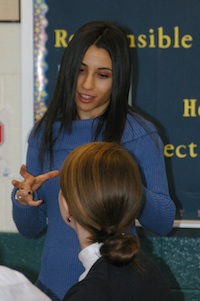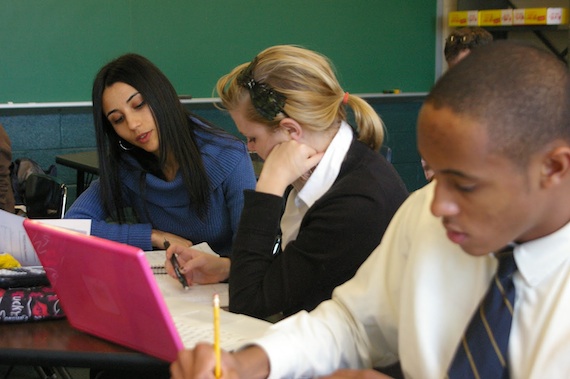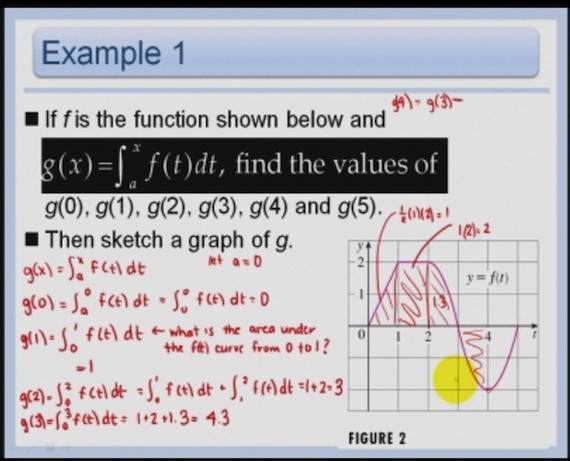The Backwards Class
- By Dian Schaffhauser
- 02/02/11

Stacey Roshan has begun pre-recording lectures so that class time can be spent answering questions and getting one-on-one assistance. |
A fairly new teacher has come up with a way to help her anxiety-ridden AP Calculus AB students relax more in class. She's using an approach dubbed by her students as the "backwards classroom." The practice can be used with or without computers or other smart devices, and the results have been remarkable: There's evidence that achievement is improving and that the teaching style suits motivated students well.
What's the approach?
The students watch pre-recorded lectures the night before the class, when homework problems are traditionally done, then spend the time in class getting answers to questions, working on additional problems with partners, and getting one-on-one assistance from the teacher. No more lectures in class.
Stacey Roshan, an instructor at Bullis High School in the affluent town of Potomac, MD, remembers her first two years of teaching this particular course at the private school. "My students would leave class with that look on their face that you just don't want to see as a teacher." AP Calculus, she explained, is fast-paced, heavy on lecture and light on time to answer students' questions. "I was getting through my material as fast as I could. I really wanted a better approach," she said.
Roshan had been attending a summer conference in Boston and was just about to leave to catch a flight home when she caught a quick demo of TechSmith's Camtasia Studio, a lecture capture program that records what appears on the computer screen as well as what somebody is saying while he or she moves through the software. It also provides video editing functionality to allow the user to edit the recording and add in movie clips or other features.
Already armed with a school-supplied Fujitsu tablet PC that allowed her to write on the screen, Roshan recognized immediately that she'd hit the mother lode. "I was like--Wow!--this is exactly what I need. This is what's going to change my AP Calculus class next year."
She set herself a straightforward goal for the academic year to come: to create a video for each section in the textbook used in her class, James Stewart's Calculus: Concepts & Contexts, published by Cengage Learning's Brooks/Cole imprint.
How Backward Learning Works
Roshan uses Microsoft PowerPoint to recreate problems from each chapter of the textbook. She turns on Camtasia and begins talking her way through the solution to the problem. "I'm just capturing my screen and my voice," she said. The recordings, which she edits and posts to a school-hosted site, a Camtasia-hosted site, as well as to iTunes, run between 10 and 30 minutes long. So far she's made 32 of them, covering six chapters in the book.
Spending that extra time preparing the videos is "the only negative," she said. "That whole process is pretty time-consuming." For a 30-minute lecture, she spends 30 minutes recording and another 45 editing it.
Roshan's favorite feature in Camtasia is the ability to point at something on the screen with her touch pen and have the program create a big yellow dot circling whatever is being pointed at. "I add that after I've recorded my video," she explained.
For the class, she hands out a chapter's worth of PowerPoint printouts to the students at a time. The expectation is that they'll write on those handouts to work out exactly what she's doing in the recorded lectures as they're watching it at home. When they have a question, they make note the time in the lecture when it surfaced. Since several of the students bring their laptops into class, they can replay the recording to go back to that point in the lecture and cover their questions with their classmates or the teacher.
Once the class has worked through its questions from the PowerPoint slides, they do additional problems, which formerly would have been their homework. "Now it's class work," Roshan pointed out.
She encourages students to work on the problems with a partner in the class. As for Roshan, she spends the time "just walking around seeing what they need help with. Some are asking me homework questions. Some are asking me questions from the PowerPoints. Whichever it is, it's totally fine. They're able to work at their own pace."

Since switching up her teaching method, she said, Roshan now spends class time assisting students as they work at their own pace. |
"It's like I have one-and-a-half the amount of time that I had before," Roshan said.
Student Response: Less Anxiety
Julia, a 17-year-old junior, remembered her first day in Roshan's AP Calc class. "We were handed PowerPoints and told to go on our school's Web site, where we'd find a link to video lectures, and that was our homework." The approach, she said, "definitely had some shock value to it. It's so different. You're not just sitting in class and hearing the lectures. It's the opposite of what you'd think of a classroom."
She said the approach has worked for her. "I enjoy watching the videos, and then I can go back and re-watch parts that I didn't feel okay with." When a question arises, she writes it down on the slide and brings it to class. "Last year [in a different math class], we'd go home and do the homework. We'd have so many questions along the way, we'd end up forgetting, but they'd continue resurfacing in class. This is a different approach, but it's worked out well for me." And, she added, "It's made math class less full of anxiety."
The practice is still too new for Roshan to have definitive proof that it improves students' understanding of the subject. But this trained economist-turned-high-school-math-teacher did say this: "Based on last year's grades to this year's grades, it's been an almost 3 percent increase. I've given the same exact tests and quizzes as last year, so that's pretty significant. And I would like to think it's because of the format."
Spreading the Word and the Work
The approach of recording lectures has been adopted by one other fellow teacher at the school, who's putting together brief clips to prime the start of a new topic in her science classes.

A still from one of Roshan's recorded lectures. The videos can be accessed at a school-hosted site. |
Also, Roshan's own AP Calc clips, which she makes available freely for others to use, have been picked up by teachers at other schools. Roshan heard from one who said she had to be absent for a few days and had the substitute play Roshan's videos. "The AP curriculum has a rushed pace. You can't miss a day. Otherwise you start to panic," she explained. "You build up this resource for your students to use later. That's the added benefit. That lecture can happen as many times as a student wants it to happen."
The approach Roshan is using with the AP Calc class wouldn't work for everybody, she observed. For example, a regular calculus class she teaches has a bunch of seniors in it who have already been accepted to college. As she put it, "They're already checked out. Their quality of homework these days hasn't been that great. To introduce it at this point would be silly."
So she advised anybody else who wants to try out the backwards classroom approach to be selective about the class where it's tried. "If you want to use it as your sole source of lecturing, make sure you have the right group of students. They have to really be putting a lot of effort into their homework." The difference is this, she said: "My AP students are very self-motivated. They're going to sit and watch that video for real comprehension."
However, Roshan also added that her next goal is to introduce the same practice into her algebra 1 class. A lot of those students get help from their parents, who may not remember much algebra. "So it would be nice for parents to be able to sit with their child and watch it with them." And she noted, a lot of those students also have tutoring help, so the lectures could be a useful resource to show tutors how she's teaching the lessons.
For next year Roshan also said she expects to rework some of the videos she's already made. For example, "if we were looking at graphs, I'd love to put some interactive features in--some little applets--that would allow students to move the graph around. Then I think these would be really special. For now it's just a lecture."